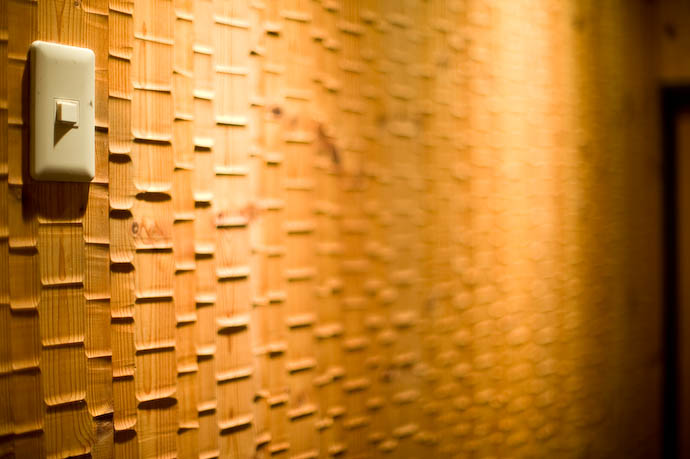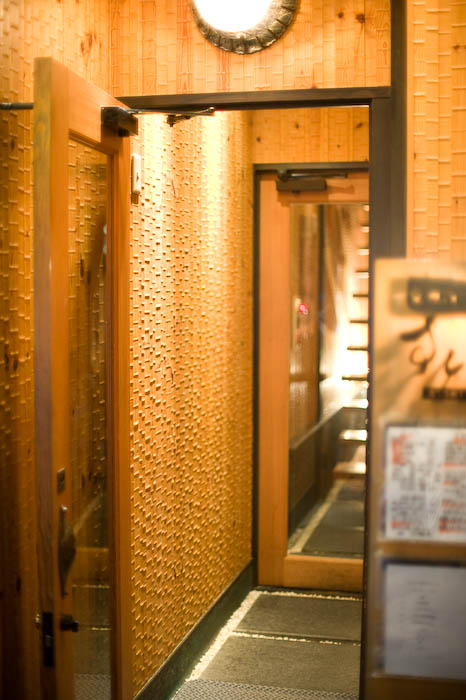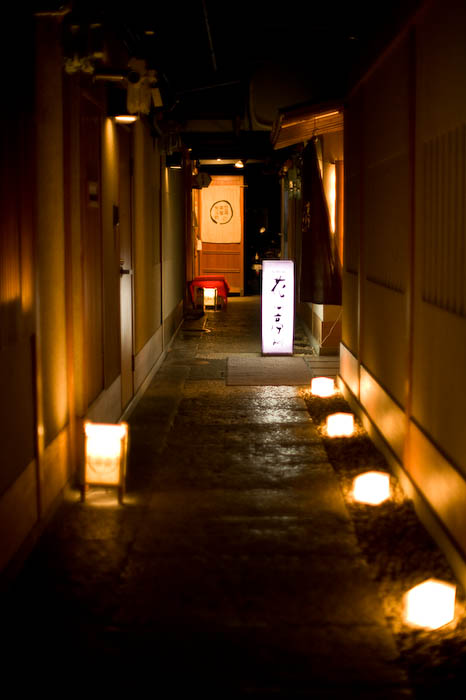
Nikon D700 + Nikko 50mm f/1.2 — 1/125 sec, f/1.2, ISO 640 — map & image data — nearby photos
Textured
A shot from my recent Impossible Photography outing, where I used a very fast lens (Nikkor 50mm f/1.2) and the Nikon D700's low-light performance for some night photography in Kyoto.
This was the entrance foyer of a restaurant that had plenty of light.... I only needed ISO 1100 at f/1.2 and 1/100sec for the wider shot....
It reminds me a bit of the front desk at the Four Seasons Resort, Whistler, although this was perhaps more out of place.
The low-light performance still doesn't help with the problem of dynamic range.... of being able to capture/display the detail in dark shadows at the same time as capturing/displaying detail in relatively brighter areas. Our eyes are much better at this, but I'm sure some day technology will catch up. (After all, it's just counting photons.)
Here's a perfect example of the dynamic-range problem, with even dim lanterns “blowing out” the sensor, which was using an exposure aimed at capturing detail in the darker portions of the frame.....
Unlike the first two pictures in this post, or the others in the original post, this last one has had some post-processing. In Lightroom, I “painted” negative exposure on the big lighted sign in the center, to bring out some of the letting, which had been totally blown-out white. It reveals that the name of the place is kashintei (花心亭), for whatever that's worth.
Because of the strange things that happen to digitally-encoded colors near the limits of brightness, I also painted on a lot of desaturation, so that the sign wouldn't turn wonky, unrealistic colors as I toned down its brightness. Perhaps the sheer whiteness I ended up with looks odd in this decidedly warm scene, so I should have painted on a bit of the yellow-orange that is pervasive everywhere else. Lightroom allows for that, but I haven't figured out a way to sample a color from the image when selecting a color to tinge with, so at this point it's more trouble than it's worth. (I've been running a fever on and off today, so I have a low threshold for trouble.)


“Nikon D700 + 0mm f/0” – I wonder why the lens details showed up correctly in the previous Impossible Photography post?
It showed up correctly in the first post because I wasn’t too sick while writing it to correct the automatically-created data. The Nikkor 50mm f/1.2 is a totally manual, non-CPU lens, so it offers no information for the camera to include in the Exif data. Thus, I have to correct it by hand if I want to include it here….. if I remember. I have now, thanks.
Both posts are impressive, and I think the first shot in the first post is very evocative, the brightness just right. For some of the others I’d agree with Zak: just a bit too bright to look realistic – to me.
I think part of the brightness problem is that I thought the camera was underexposing everything because I had the LCD brightness turned all the way down, but unlike doing the same thing with my D200, on the D700 LCD it caused the shadows to turn black. I’ve since returned the LCD to standard brightness. As for Zak’s sense of color and brightness, check out his amazing shot of a “hozuki” (a freaky kind of plant). —Jeffrey
While I confess that I was lost in the techtext, I found the wood wall photo arresting. Decided that it was done with a router and a table saw, or possibly Hollows & Rounds Hand Planes. Router with Cove bits most probably, then ripped and arranged. Very clever..loved it. Also love your new little niece Jena. Darling baby at one week of age.
You can sample a tint colour from a photo (or anywhere on screen) by opening the colour selection box and dragging (a pipette is shown) from the colour palette to wherever you want to sample from. I discovered this by accident.
Wow, that’s unintuitive. Thanks! —Jeffrey
You know, it’s tempting when we get new hardware to try to max everything out and try for the most extreme possible shots. But you know when you will really start to be impressed by the D700? Everyday shots that are just that little bit better. The times when you couldn’t quite stop the action or got just a little bit too much grain. They won’t be “extreme” settings and apertures, but your window for good images is just a little bit more open now across all of your shooting.
Also, the D700 actually has excellent dynamic range compared to your old D200. I saw a chart on Nikonians which showed a substantial difference (D3 and D700 both exceed Nikon’s earlier cameras by quite a bit in stops of DR)
But of course you are right… the combination of our eyes, computer monitor standards and camera sensors means we may never see true full dynamic range, or it may be uncomfortable/unuseful in practice to look at if a monitor / display and sensor system were ever developed. And processed HDR images never quite look right- they may show more detail but rarely any more realism.
On the subject of dynamic range, have you taken full advantage of the dynamic range available in the RAW files?
I found that Lightroom’s highlight recovery is too limited to get out all that information that’s there. Specialist tools designed for HDR images do a much better job, even if they are fed with a single RAW file.
I’ve played a bit with Lr/Enfuse, but I don’t know that I’ve taken full advantage. If something is a bit overexposed, I’ve found it better to lower the exposure then raise the brightness, since they work differently in the upper end of the luminance range. In the end, you’ve still got the problem of trying to fit too-big a range into too-small a range of the print/view device, so at this point, it’s all still just shuffling stuff around within the same limits. )-: —Jeffrey
Hi, I want to get a digital camera that will let me take manual pictures, I borrowed my friends D70 but it wouldn’t let me take the pics, I’d press the trigger and nothing would happen. What digital camera do you recommend that will let me take pictures on manual and there fore take night and actions pictures. I travel a lot and like to bring home lots of pictures.
Thanks
Nikon SLRs (and perhaps other makers’ as well) have a setting that governs what the camera should do if you press the shutter-release while it senses that the image is not in focus. If set to “Shutter priority”, the picture will be taken regardless, but when set to “Focus priority”, the camera will not take the shot until it senses focus. This can be very frustrating when it doesn’t work quite right, and my D700 has had more issues in this regard than my D200 has. Still, they’re rare. —Jeffrey
Joe